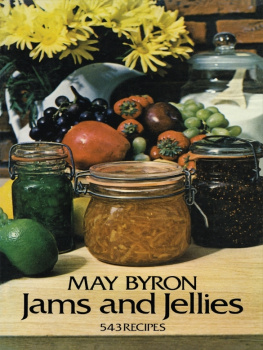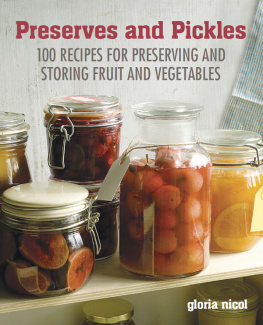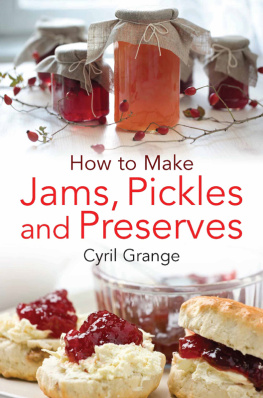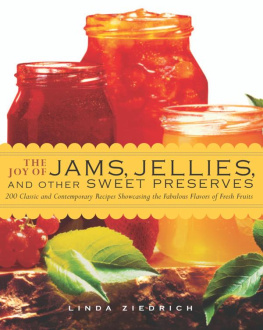Jams, Jellies & More
Excerpted from The Big Book of Preserving the Harvest, by Carol W. Costenbader

The mission of Storey Publishing is to serve our customers by publishing practical information that encourages personal independence in harmony with the environment.
Edited by Dianne M. Cutillo, Claire Hopley, and Carey L. Boucher
Cover design by Carol J. Jessop (Black Trout Design)
Cover illustration by Mary Rich
Interior illustrations by Alison Kolesar, except those on , by Mary Rich
Text production by Jennifer Jepson Smith and Kelley Nesbit
2003 by Carol W. Costenbader
All rights reserved. No part of this bulletin may be reproduced without written permission from the publisher, except by a reviewer who may quote brief passages or reproduce illustrations in a review with appropriate credits; nor may any part of this bulletin be reproduced, stored in a retrieval system, or transmitted in any form or by any means electronic, mechanical, photocopying, recording, or other without written permission from the publisher.
The information in this bulletin is true and complete to the best of our knowledge. All recommendations are made without guarantee on the part of the author or Storey Publishing. The author and publisher disclaim any liability in connection with the use of this information. For additional information please contact Storey Publishing, 210 MASS MoCA Way, North Adams, MA 01247.
Storey books and bulletins are available for special premium and promotional uses and for customized editions. For further information, please call 1-800-793-9396.
Printed in the United States by Walsworth Publishing Company
Library of Congress Cataloging-in-Publication Data
Costenbader, Carol W.
Jams, jellies & more / Carol W. Costenbader.
p. cm.
ISBN 978-1-58017-880-8
1. Jam. 2. Jelly. 3. FruitPreservation. I. Title: Jams,
jellies, & more. II. Title.
TX612.J3C67 2003
641.852dc21
2003005072
Making jams, jellies, marmalades, and other fruit spreads transforms the bounty of the harvest into beautiful rows of jars full of delicacies that last right into the leanest days of winter.
The art and science of turning fresh fruits into tempting fruit spreads is endlessly satisfying. My seasonal ritual often includes berry picking with children. Frequently, young berry pickers like to help make jam as well. The perfume of simmering fruit wafting through the house makes memories for everyone. Later, we savor the comforting pleasure of toast with homemade jamone of the underrated joys of life.
Jams, Jellies & More: The Basics
There are many types of sweetened jarred fruit, and the terms used to describe them can be confusing. Here are some definitions.
Butter. This easy-to-make, naturally thickened fruit spread is most often made from pured apples, pears, or pumpkin; sugar; and sometimes spices.
Conserve. In the nineteenth century, conserves of whole or sliced fruit in syrup were eaten for dessert. Today, conserves differ from jam in being made of two or more fruits, possibly with added nuts or raisins.
Curd. With fruit, butter, and eggs, curds are smooth, rich preserves most often made from citrus fruits, especially lemons. Curds must be refrigerated and stored for no more than 3 months.
Jam. This spread consists of washed, crushed fruit, sugar, and possibly pectin. Jam can be cooked or freezer-preserved.
Jelly. Clear and lacking in fruit pieces, jellies are made from strained fresh or purchased fruit juice, sugar, and pectin if needed.
Marmalade. Typically made with citrus fruits, marmalade is peel or fruit suspended in a jelly.
Preserve. Often used as a general term for fruit cooked with sugar to prevent decay, preserve technically refers to whole fruits in a sugar solution. The solution may be a jelly, a syrup, or anything in between.
Ingredients
The main ingredients of jams, jellies, and other spreads are fruit, sugar, and pectin. Fruit contributes distinctive flavor, sugar both sweetens and preserves the fruit, and pectin (a natural component of many fruits) is crucial for gelling. Though jams, jellies, and other fruit spreads are easy to make, always follow the recipe, changing neither the ratio of fruit to sugar to pectin nor the order in which these ingredients are added to ensure success.
Fruit. Start with the best, fresh produce. If you cannot use it immediately, you can freeze just-picked fruit for later without losing significant flavor. Simply pack the fruit without any liquid or sweetening. Theres no need to thaw frozen fruit before cooking; simply combine it with the other ingredients.
When using firm fruits, it is sometimes necessary to add cup of fruit juice for each quart of fruit. Do this only if the fruit doesnt produce its own juice within 1 minute of heating. Recipes may call for fruit acid, usually lemon juice, to be added to preserves made from fruits that lack natural acid.
Pectin. The amount of sugar and the fruits ripeness and pectin content all affect gelling. Pectin is a natural gelling agent found in fruits, especially in underripe fruits. Thus, including some under-ripe berries or fruit pieces in your fruit spread helps it to set. In recipes calling for added pectin, however, fully ripe fruit gives the best flavor.
Depending on whether pectin is added or derived from the fruit you are using, fruit spreads are either slow cooked or fast cooked. In the slow-cooking method (see ), no pectin is added and a ratio of 3 parts fully ripe fruit to 1 part slightly ripe fruit is used to produce a gel. This method requires more guesswork than the fast-cooked method, so it is chancy for the less experienced cook.
Liquid or Powdered Pectin?
Either one works well, but dont substitute liquid for powdered pectin in a recipe or vice versa; the change may affect the gel. Always follow directions on the package and in the recipe for adding the pectin to the fruit mixture.
7), less fruit is required because pectin is added. The recipe tells the exact quantity and cooking time. Never cook a pectin-added recipe for more than 20 minutes or the pectin will break down.
Sugar and Sweeteners. You may use various sweeteners to make your fruit spreads:
Pectin and Acid in Fruit
The amount of naturally occurring pectin and acid in fruit varies and depends on ripeness. The fruits in the following columns are listed from the highest pectin and acid content to the lowest.
Fruits with High Natural Pectin and Acid
Sour apples
Plums (damson)
Blackberries
Crab apples
Cranberries
Grapes (Eastern Concord)
Quinces
Currants
Citrus fruits
Fruits with Low Natural Pectin and Acid
Apricots
Peaches
Grapes (Western Concord)
Guavas
Figs
Prunes
Pears
Raspberries
Sugar. Granulated cane or beet sugar or light brown sugar can be used. In addition to sweetening and preserving, sugar helps gelling. Never change the ratio of sugar to fruit to pectin.
Honey. A light, mild honey can replace sugar. It has double the sweetening power of sugar and, therefore, fewer calories. Dont simply switch from sugar to honey, however; choose a recipe formulated for honey use.










